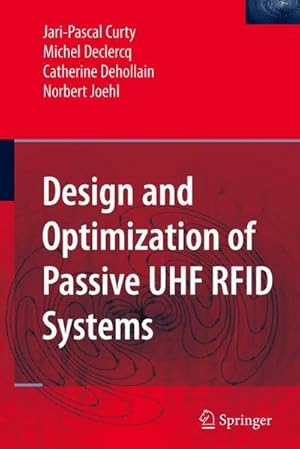9781441941992 - Design and Optimization of Passive UHF RFID Systems von Curty, Jari-Pascal (1 Ergebnisse)
Produktart
- Alle Produktarten
- Bücher (1)
- Magazine & Zeitschriften
- Comics
- Noten
- Kunst, Grafik & Poster
- Fotografien
- Karten
-
Manuskripte &
Papierantiquitäten
Zustand
- Alle
- Neu
- Antiquarisch/Gebraucht
Einband
- alle Einbände
- Hardcover
- Softcover
Weitere Eigenschaften
- Erstausgabe
- Signiert
- Schutzumschlag
- Angebotsfoto
Land des Verkäufers
Verkäuferbewertung
-
Design and Optimization of Passive UHF RFID Systems
Verlag: Springer US, 2010
ISBN 10: 1441941991ISBN 13: 9781441941992
Anbieter: AHA-BUCH GmbH, Einbeck, Deutschland
Buch
Taschenbuch. Zustand: Neu. Druck auf Anfrage Neuware - Printed after ordering - Radio Frequency IDentification (RFID) is an automatic identification method, relying on storing and remotely retrieving data using devices called RFID tags or transponders. An RFID tag is a small object that can be attached toor incorporated into a product, animal or person. An RFID tag contains an antenna to enable it to receive and respond to Radio-Frequency (RF) queries from an RFID reader or interrogator. Passive tags require no internal power source, whereas active tags require a power source.As of today (2006), the concepts of ubiquitous computing and ambient intelligence are becoming widespread. In order for these to become a reality, a number of key technologies are required. In brief, these technologies need to be sensitive, responsive, interconnected, contextualised, transparent and intelligent. RFID, and in particular passive RFID tags, are such a technology. In order to deliver the necessary characteristics that could lead to ambient intelligence, however, there are some challenges that need to be addressed.Remote powering of the tags is probably the most important challenge. Issues concerning the antenna-tag interface and the rectifier design, that allow the RF signal to be converted to Direct Current (DC) are top priorities. Secondly, the communication link and the reader should be optimized. The RF signal that contains the tag data suffers from a power of four decay with the distance between tag and reader. As a result, both the reader sensitivity and the tag backscattered power efficiency have to be maximized. Long-range powering, as well as sufficient communication quality, are the guidelines of this work.This work proposes a linear two-port model for an N-stage modified-Greinacher full wave rectifier. It predicts the overall conversion efficiency at low power levels where the diodes are operating near their threshold voltage. The output electrical behavior of the rectifier is calculated as a function of the received power and the antenna parameters. Moreover, the two-port parameter values are computed for particular input voltages and output currents for the complete N-stage rectifier circuit, using only the measured I-V and C-V characteristics of a single diode.Also presented in this work is an experimental procedure to measure how the impedance modulation at the tag side affects the signal at the reader. The method allows the tag designer to efficiently predict the effect of a modulator design at the system level and gives a useful instrument to choose the most appropriate impedances.Finally, the design of a fully-integrated, remotely powered and addressable RFID tag working at 2.45GHz is described. The achieved operating range at a 4W Effective Isotropically Radiated Power (EIRP) reader transmit power is at most 12 m. The Integrated Circuit (IC) is implemented in a 0.5 um silicon-on-sapphire technology. A state-of-the-art rectifier design is embedded to supply energy to the transponder. Inductive matching and a folded-dipole antenna are key elements for achieving this performance.


